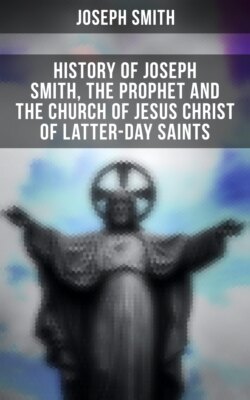Читать книгу History of Joseph Smith, the Prophet and the Church of Jesus Christ of Latter-day Saints - Joseph F. Smith - Страница 63
На сайте Литреса книга снята с продажи.
Footnotes
Оглавление1. The mob consisted of from three to five hundred.—Times and Seasons, vol. 1, p. 18.
2. The incident is thus described in the Times and Seasons, vol. 1, p. 18: "In a short time hundreds of the mob gathered around the printing office, which was a two story brick building, which they soon threw down. The press was thrown from the upper story, and also the apparatus, book work, paper, type, etc. A family residing in the lower story was also thrust out in great haste. After destroying the printing establishment, they proceeded to Gilbert & Whitney's store for the same purpose, but Gilbert agreeing to box the goods, soon, they concluded to let it alone."
3. They succeeded in taking Charles Allen, whom they tarred and feathered upon the public square, surrounded by hundreds of the mob. A number more were taken, but they succeeded in making their escape, through the over anxiety of their keepers, who wished to have the "sport" of seeing those who were being tarred.—Times and Seasons, vol. I, p. 18.
4. The Prophet's statement on this head is abundantly sustained even by those historians who become apologists for the actions of the mob, and also by the declaration put forth by the mob themselves. It will be remembered that in the "Mob Manifesto," or "Secret Constitution," (p. 374, this volume) those who signed it justified their determination "to rid their society of the Mormons" by resorting to mob violence because, said they, "we believe that the arm of the civil law does not afford us a guarantee, or at least a sufficient one, against the evils which are now inflicted upon us." In the address adopted at their meeting of the 20th of July, which was published in the Western Monitor (see p. 396) the mob further excuse their lawless intentions by saying: "The evil is one that no one could have foreseen, and therefore is unprovided for by the laws; and the delays incident to legislation would put the mischief beyond remedy." In all of which one plainly sees unconscious admission that the Saints were not guilty of infraction of the laws of the land. As to the historian apologists referred to in the opening sentence of this note, I quote the following statements from the "History of Jackson County, Missouri," published by the Union Historical Company, Kansas City, Missouri, 1881: "Assuming this that they [the Saints] were the holy people of the Lord, that the Lord was the real owner of all things, and that all His possessions were free to them, they were not calculated to be very respectful of the rights and interests of their non-Mormon neighbors. But though no overt acts of transgression upon such rights were being committed, the rapidly gathering members of the Mormons * * * made the new sect an object of profound solicitude to the people." (See also comment of Parley P. Pratt on charges of the mob, 5th paragraph in note at p. 377 this volume).
5. It was at this point, too, that several of the brethren stepped forward and offered themselves as a ransom for the Church, expressing themselves as being willing to be scourged or to die if that would appease the anger of the mob against the Saints. The mob would not accept the sacrifice of the brethren, however, but renewed their threats of violence against the whole Church. The brethren who offered themselves as a ransom for the Saints were John Corrill, John Whitmer, William W. Phelps, Algernon S. Gilbert, Edward Partridge, and Isaac Morley.
6. This agreement was signed on the part of the brethren by Edward Partridge, Isaac Morley, John Corrill, W. W. Phelps, Algernon S. Gilbert, and John Whitmer; and on the part of the mob by the Mob Committee whose names are given in the article from the Western Monitor, page 399.
7. Fayette was the county seat of Howard county, about one hundred and fifty miles directly east of Independence.
8. The document is already printed in full on pages 394, 395.
9. Doctrine and Covenants, sec. xcvii. Respecting the School of the Prophets referred to in the above revelation, Elder Parley P. Pratt, whose course is so highly commended in the revelation, writes in his Autobiography, page 100: "In the latter part of the summer (1833) and in the autumn, I devoted almost my entire time in ministering among the churches, holding meetings, visiting the sick, comforting the afflicted, and giving counsel. A school of Elders was also organized, over which I was called to preside. This class, to the number of about sixty, met for instruction once a week. The place of meeting was in the open air, under some tall trees, in a retired place in the wilderness, where we prayed, preached and prophesied, and exercised ourselves in the gifts of the Holy Spirit. Here great blessings were poured out, and many great and marvelous things were manifested and taught. The Lord gave me great wisdom, and enabled me to teach and edify the Elders, and comfort and encourage them in their preparations for the great work which lay before us. I was also much edified and strengthened. To attend this school I had to travel on foot, and sometimes with bare feet at that, about six miles. This I did once a week, besides visiting and preaching in five or six branches a week."
10. "This revelation," writes Elder Pratt (Autobiography, p. 102), "was not complied with by the leaders and Church in Missouri as a whole (notwithstanding many were humble and faithful); therefore, the threatened judgment was poured out to the uttermost, as the history of the five following years will show."
11. Doctrine and Covenants, sec. xcviii.
